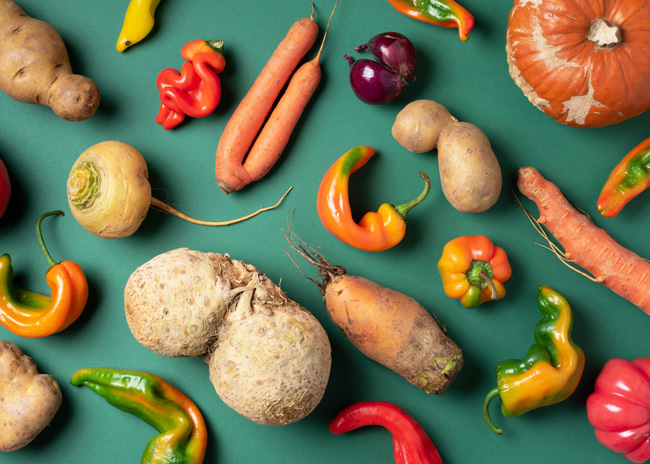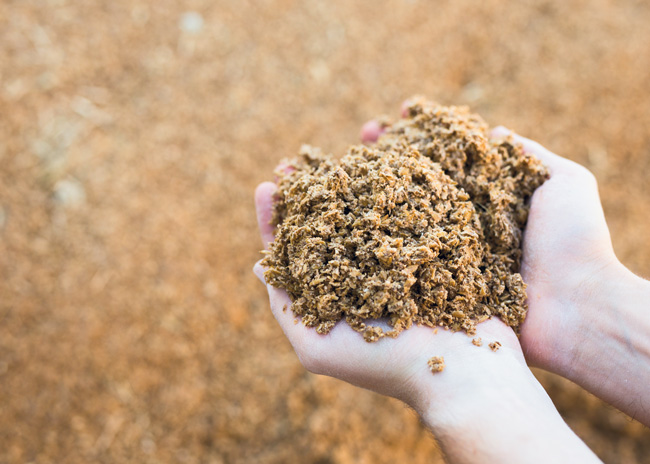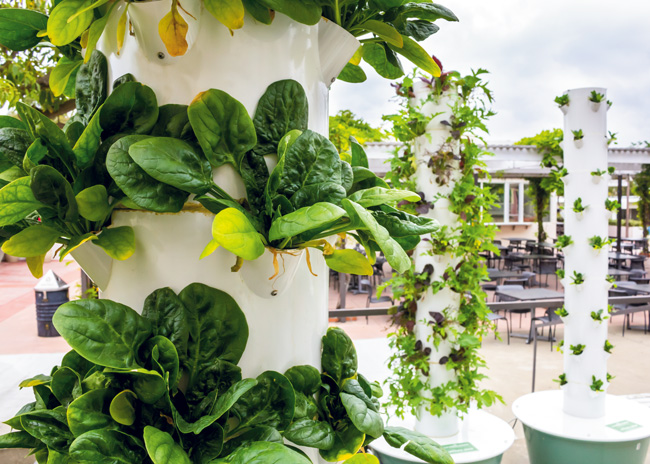Here, ways the sustainability needle continues to move in support of greener menus and back-of-the-house operations.
About two-thirds (62%) of U.S. foodservice operators believe sustainability is becoming standard in the industry, according to Datassential. The evolution of many of the first iterations of sustainable kitchen practices continues, including farm-to-table ideals, local food sourcing, whole animal butchery and on-site gardens. Dive deeper into some ongoing eco-friendly kitchen practices today.
Upcycling
 In the mid-2000s, there was a big push among leading chefs to save their trimmings, peels, scraps and what would otherwise be considered trash for use in soups, stocks and other kitchen creations. Today, they’re taking the idea of reduce via reuse one step further. Upcycling refers to the rescuing of byproducts from food and beverage production for use to create new food and beverage products.
In the mid-2000s, there was a big push among leading chefs to save their trimmings, peels, scraps and what would otherwise be considered trash for use in soups, stocks and other kitchen creations. Today, they’re taking the idea of reduce via reuse one step further. Upcycling refers to the rescuing of byproducts from food and beverage production for use to create new food and beverage products.
For example, chefs and artisan food makers are turning butcher trimmings into jerky, using spent grains from breweries to bake bread, rescuing apple cores from juicers for pastries, creating gluten-free flour out of tofu pulp and much more. Portland, Ore.-based Salt & Straw’s head ice cream maker uses whey leftover from yogurt makers in upstate New York to make lemon curd, mixing in grains from beer brewing for a chocolate barley flavor.
In San Francisco, Shuggie’s Trash Pie’s pizza menu features many upcycled products, from so-called ugly produce like misshapen peppers and discolored tomatoes rejected by retailers to leftover oats used in oat milk production to fish scraps from local fisheries for use in specials and sauces.
Fast Fact
- The upcycled food economy was estimated at $52.9 billion in 2022, according to Innova Market Insights.
- 63% of consumers would like to eat at a restaurant that actively prevents or reduces food waste, according to Datassential.
Regenerative Agriculture
According to the American Horticultural Society, nutrient values in produce over the last 50 to 100 years have decreased because of modern agricultural practices. While many chefs have long sourced produce from organic, local and smaller, sustainable farms, the next iteration of this is sourcing from farms that focus specifically on regenerative agriculture — a term used to describe farming practices that aim to restore soil health, improve crop biodiversity, remove carbon from the atmosphere and improve water quality.
It’s an ancient farming practice, but one that requires many modern sustainability methods to execute in today’s world. Datassential noted this macro trend last year in its “Food Trends” report, suggesting that the term regenerative agriculture would start showing up everywhere.
The Chef’s Garden, a farm owned by Farmer Lee Jones and his family in Ohio that has supplied organic produce and microgreens to top chefs around the country, was an early adopter of regenerative agriculture. “We’ve been looking for ways to increase nutrient density and organic matter through natural means,” said Jamie Simpson, executive chef of the Culinary Vegetable Institute, a research and knowledge center for chefs at The Chef’s Garden, when discussing regenerative agriculture during the company’s Roots Conference in September 2023.
Fast Fact
Today, only 20% of consumers say they’ve heard the term regenerative agriculture, according to Datassential. Perhaps that will change as 2024 unfolds and the term appears more often in the media, on food packaging, in marketing and even on menus. Indeed, while the term may be new to consumers, 70% of consumers told Datassential they agree that the food they eat should be grown on farms that use sustainable practices.
Climate-Conscious Crops
Some progressive sourcing measures chefs use now include avoiding or cutting down on ingredients that require more resources, like water and energy. Instead, chefs favor drought-tolerant, climate-friendly crops that can withstand major changes in weather. In other words, they’re reaching for cacti, seaweed, shellfish and pulses over commercially produced meats and water-thirsty nuts like almonds.
 Consumers are becoming more aware of this movement, thanks to new initiatives and innovations. For example, Chartwells Higher Education recently launched a climate labeling program at college campuses through a partnership with a company that created a sustainability rating system. Chartwells stated that the goal is to educate diners about their options and help operators meet their carbon reduction goals.
Consumers are becoming more aware of this movement, thanks to new initiatives and innovations. For example, Chartwells Higher Education recently launched a climate labeling program at college campuses through a partnership with a company that created a sustainability rating system. Chartwells stated that the goal is to educate diners about their options and help operators meet their carbon reduction goals.
The Climatarian Diet
“A small-but-growing cohort of consumers is experimenting with an unconventional diet — one that doesn’t have anything to do with losing weight, but rather, saving the planet,” states Samantha Des Jardin in Datassential’s “Deep Dive: Diet Trends” section of its 2023 “Trend Watch” report.
Enter the climatarian diet, which involves reducing a person’s intake of emissions-producing or resource-intensive foods like animal protein and ingredients that travel long distances to reach supermarket shelves or are not in season.
Fast Fact
- 22% of consumers report they are interested in practicing a climatarian diet according to Datassential’s “Deep Dive: Diet Trends” section of its 2023 “Trend Watch” report.
- 30% of consumers believe food brands and restaurants should take a stand and have a public position on climate health, according to Datassential’s 2022 “New Food Values Keynote Report.” Just 21% of operators said they planned to do that in the next 2 years.
Lesser-Known and Off-Cuts
Whole animal butchery (also called nose-to-tail dining) was a fast-growing practice at restaurants several years ago, but not all facilities include the necessary space, the right labor or the resources to source and break down whole carcasses or large primal cuts in-house. As an alternative, more chefs are simply buying off-cuts of beef like the shoulder tender, bavette and hangar, as well as offal and organ meats. Culinary teams agree these items do require a little more cooking finesse to pull off, as well as gaining buy-in from restaurant guests to try the end result.
Some chefs execute this extremely well. At Jewel of the South, which describes its restaurant as a classic New Orleans tavern reimagined, Chef Philip Marsh built his entire shared plates menu around this concept. Dishes include lamb belly haggis, Wagyu beef tongue, morcilla (blood sausage) and tripe escabeche.
Some seafood restaurants are likewise following the lesser-known trend. For example, Red’s Best in Boston, Jack Dusty in Sarasota, Fla., and Herb & Sea in Encinitas, Calif., all often feature lesser-known fish, including bycatch like sheepshead and opah, and even invasive species like lionfish.
On-Site Herbs and Hydroponics
Growing produce on-site no longer requires soil. Hydroponic solutions have flooded the marketplace in recent years, allowing operators the capability to grow vegetables and herbs indoors year-round. Small and large-scale equipment options exist, in both horizontal and vertical formats that create space-saving growing solutions — many systems require only hydration tablets and a little maintenance here and there.
 Microsoft was an early adopter of vertical hydroponic towers in the mid-2000s for its on-site employee dining space. More recently, Farm & Market, a Denver concept housed in a 6,000-square-foot facility, amps this idea up a notch with its hydroponic farm that serves as a focal point for the fast-casual bowl restaurant and fresh market. The hydroponic farm grows more than 50 varieties of greens and other plants through a 1,000-plus tower system with a self-managed, recirculating watering system.
Microsoft was an early adopter of vertical hydroponic towers in the mid-2000s for its on-site employee dining space. More recently, Farm & Market, a Denver concept housed in a 6,000-square-foot facility, amps this idea up a notch with its hydroponic farm that serves as a focal point for the fast-casual bowl restaurant and fresh market. The hydroponic farm grows more than 50 varieties of greens and other plants through a 1,000-plus tower system with a self-managed, recirculating watering system.
Another spin on this idea comes by way of a hotel property in Florida. Omni Amelia Island Resort boasts an expansive greenhouse using aquaponics, circulating fish and fish waste to feed and grow various types of lettuce and other plants. Dubbed The Sprouting Project, resort guests can book an experience to see the state-of-the-art setup close-up. A collection of beehives, an organic garden, a barrel room and a chicken coop round out the project.
In the education segment, Canisius University in Buffalo, N.Y., grows more than 50 types of leafy greens, herbs and edible flowers on-site in vertically stacked hydroponic units. In November 2023, the university announced it will implement new initiatives aimed at advancing an eco-sustainable campus environment. And, at Vernon Hill School in Worcester, Mass., students can pluck fresh produce and herbs from inside a freight container set up for hydroponic growing through 2Gether We Eat, a local youth hydroponic farming nonprofit.
Some senior living facilities are also on the hydroponic bandwagon. Commonwealth Senior Living based in Charlottesville, Va., was recognized by a senior living association for its efforts in this area. Specifically, its hydroponic program, which features small hydroponic farms in its dining rooms. The program increased consumption of nutrient-rich greens by 35% according to Commonwealth Senior Living.
Root-to-Stem Cooking
Even as the plant-based movement continues, studies show plant-based analogues (like Impossible Burger and Beyond Meat) are falling out of favor as consumers prioritize less-processed, whole foods. Chefs are responding to this, creating their own veggie burgers or reaching for mushrooms over meat and making produce the center protein of the plate.
Before it was a term, New York Chef Dan Barber was a big proponent of root-to-stem cooking — the practice of using all parts of the plant for various parts of a dish to reduce waste, akin to nose-to-tail cooking. Other chefs joined the movement quickly, making cilantro- and parsley-stem chimichurri, carrot top pesto, sauteed beet greens and more.
In Atlanta, Chef Jarrett Stieber and bar manager Charles Howk of Little Bear work together to use all parts of the local food they source, making liqueur out of melon skins, using herb stems for infusions and crushing dehydrated trim for seasoning powders.
Simpson with the aforementioned Culinary Vegetable Institute is a big proponent of this — using everything from the vegetable roots to the leaves, stems, fruits, blossoms and pollen. He’s known for his sandwiches filled with cured root vegetable slices meant to mimic ham or pastrami.
Preservation and Fermentation
Fermenting vegetables and making vinegar are ancient forms of food preservation that chefs practiced quietly years ago due to strict health department regulations. However, thanks to widespread education, Hazard Analysis Critical Control Point plans and new equipment hitting the market, chefs now take much greater liberties with preserving their own foods on-site. Chefs today have access to kimchi cabinets and other fermentation cabinets designed to pass health inspections.
Consumers are open to trying these foods: 63% of diners are more likely to visit restaurants that preserve, can, pickle or ferment foods, according to Datassential’s 2022 “Keynote Report on Sustainability.”
To preserve produce at peak harvest, many operators, especially in the noncommercial space, are installing blast chillers where space permits. This has become easier (and more affordable) thanks to smaller versions of equipment now on the market. A handful of chefs are dry-curing their own beef and even fish using dry-curing cabinets small enough to sit on a countertop or narrow enough to squeeze between other pieces but large enough to cure several slabs of ribs or steaks at a time.
Composting On-Site
The push for widescale food waste reduction has been going on for well over a decade. Following the recycling campaigns of the ’90s, organic composters and disposers hit the marketplace in the early-to-mid-2000s, along with software programs and scales that track waste going into garbage cans and landfills. Nowadays, there’s an even stronger focus on organic waste, as these once huge, expensive composters are getting smaller and, in some cases, more affordable.
“You’re not going to get to net zero waste (which is really more like 90%) through recycling more cardboard, glass and plastic; you have to do it through organics,” says Joe Sorgent, director of sustainability, Cini-Little International Inc. “There was a study that came out of California showing that a little over 40% of its methane production came from landfills. Fortunately, on-site composters are smaller than they have ever been and can make compost in 24 hours versus 6 to 8 weeks just a few years ago, which is amazing.”



